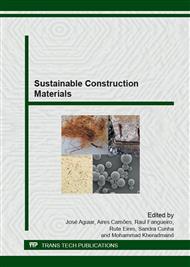p.235
p.247
p.256
p.266
p.278
p.288
p.300
p.307
p.321
Evaluation of the Influence of PU/EVA Waste-Based Lightweight Aggregates on the Physical Properties of Alkali-Activated Mortars
Abstract:
The objective of this study is to evaluate the effect of the relationship of waste polyurethane (PU) and Ethylene-Vinyl Acetate (EVA), as a replacement for conventional construction sand, on the physical properties of water absorption, bulk density and open porosity of fly ash-based and alkali-activated metakaolin mortars. By means of processing involving extrusion and milling, PU/EVA-based aggregates were prepared in three proportions: 30/70, 50/50 and 70/30. The reference alkali-activated mortars were prepared using a 1:2 (fly ash + metakaolin : conventional construction sand) ratio, by weight. The waste-containing mortars were prepared via partial replacement of construction sand with the PU/EVA waste in percentages of 10%, 20%, 30% and 40%, relative to the volume of sand. The activators used in all mortars were NaOH and Na2SiO3. The mortars were cured at 80°C for 21 hours. Based on the procedures of ASTM C 642, the water absorption, open porosity and bulk density of the alkali-activated mortars were determined at the ages of 7, 28 and 91 days. The open porosity and water absorption values increased as the amount of sand replaced with PU/EVA waste increased. The absorption values were found to be in the range from 8.0% to 17.00%. The values obtained for open porosity varied from 20.00% to 29.00%. With regard to bulk density, the behavior was reversed: increasing the amount of sand replaced by waste, decreased the bulk density value. The values ranged between 2.10 and 2.48 kg/dm3. Therefore, based on these results, mortars containing up to 40% PU/EVA have potential for use in the manufacture of non-load-bearing elements for civil construction.
Info:
Periodical:
Pages:
278-287
Citation:
Online since:
December 2014
Price:
Сopyright:
© 2015 Trans Tech Publications Ltd. All Rights Reserved
Share:
Citation:


